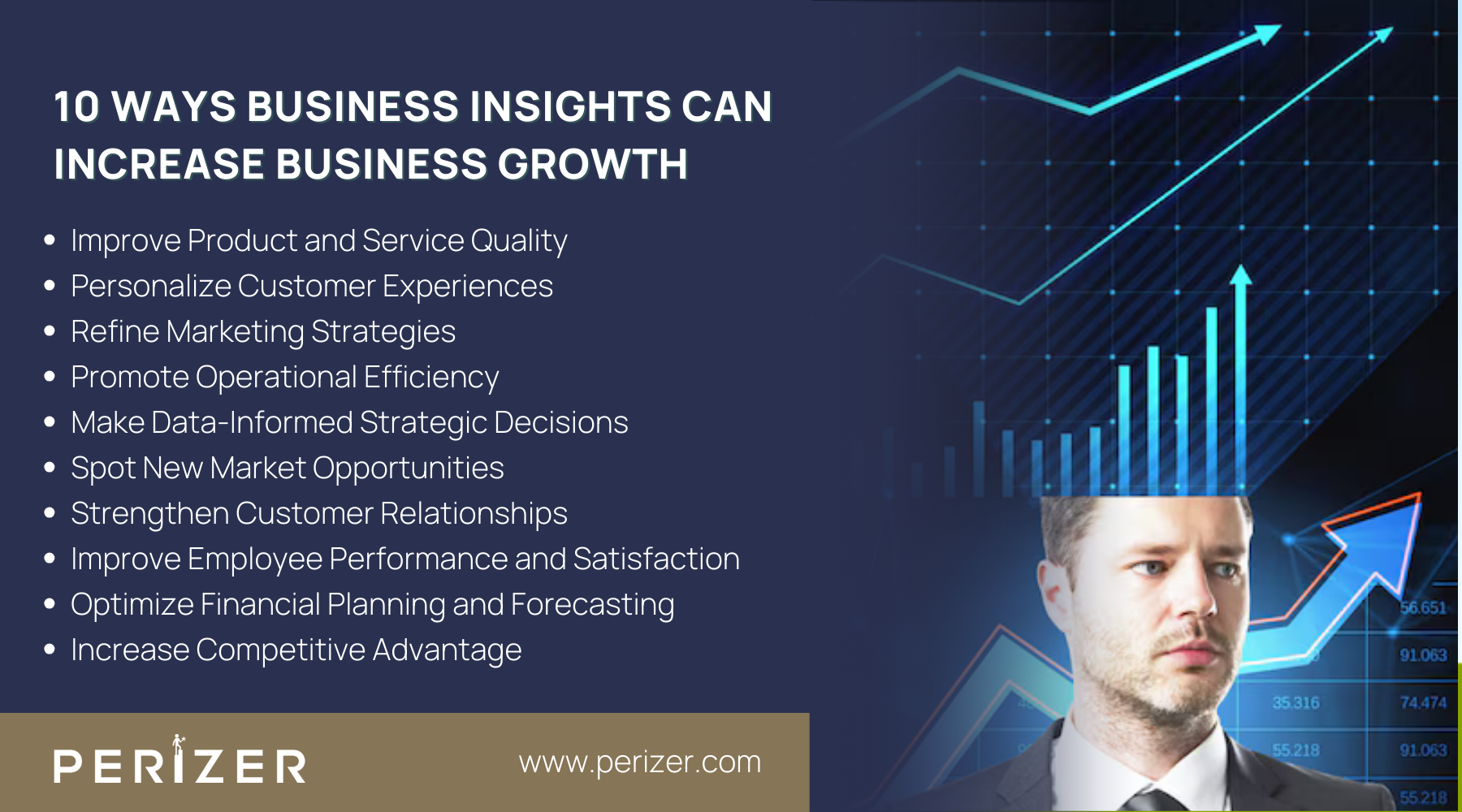Business Insights
10 Powerful Strategies to Improve Your Business Insights
Utilize business insights to drive growth by improving products, personalizing experiences, optimizing operations, and gaining a competitive edge.

If you’re not using business insights, you might be missing out on an important edge that could promote your business to new heights. In today’s market, every decision matters, and it’s the smart use of insights that sets successful companies apart from those that are merely keeping up.
It’s not just about collecting data; it’s about turning that data into actionable strategies that drive your business forward. Without insights, you risk missing opportunities and falling into an inability that could hold you back. But when used wisely, insights become a powerful tool that leads your business toward long-term growth and success.
In this article, we’ll explore 10 essential strategies for effectively using business insights.
10 Ways Business Insights Can Increase Your Business Growth

1. Improve Your Products and Services
Staying competitive demands continuous improvement of your products or services, but determining where to focus your efforts can be challenging. Here’s how business insights can guide you.
How to Improve?
Start by systematically collecting and analyzing customer feedback from surveys, reviews, social media interactions, and direct conversations. Don’t stop at surface-level comments - analysis to understand the core issues. For instance, if customers frequently complain about a specific feature, investigate whether it’s a design defect, usability issue, or something else. Once you identify the root cause, implement targeted changes.
Whether it’s redesigning the feature, improving user instructions, or even reconsidering the feature’s necessity, take action that directly addresses the customer’s concerns. Communicate these changes clearly to your customers, reinforcing that their feedback drives your product development. This approach not only refines your offerings but also builds trust and customer loyalty.
2. Personalized Customer Experience
Personalization is no longer a luxury—it’s an expectation. Your customers want to feel understood and valued. Business insights can help you deliver a superior customer experience by adjusting interactions at every touchpoint.
How to Improve?
Start by mapping the entire customer journey, and identifying key touchpoints where personalization can make a significant impact. Segment your customers based on their behavior, preferences, and purchase history.
For instance, if a customer regularly purchases eco-friendly products, conform your marketing messages and product recommendations accordingly. Real-time data analysis allows you to respond to customer actions as they happen.
For example, if a customer hesitates on a purchase, offering a timely discount or additional information can encourage them to complete the transaction. By continuously refining the customer experience based on real-time insights, you create a more engaging and satisfying journey, leading to stronger customer relationships and increased loyalty.
3. Optimize Marketing Strategies
Effective marketing goes beyond simply spreading your message; it’s about ensuring the right message reaches the right audience at the right time.
How to Optimize?
Begin by analyzing data related to customer demographics, purchasing behavior, and engagement patterns. This analysis will help you identify your most valuable customer segments. With this information, you can create highly targeted marketing campaigns that relate to these segments. Use A/B testing to refine your messaging and visuals, ensuring your campaigns are as effective as possible.
For example, test different headlines or call-to-action phrases to see which yields better engagement. Social listening tools can provide additional insights by monitoring how your brand is perceived online. If you notice a positive trend, like customers praising your sustainability efforts, amplify that message in your marketing to reinforce your brand’s strengths. By continuously adjusting your strategies based on insights, you can drive higher engagement and achieve better ROI.
4. Streamline Operations
Operational efficiency is the fundamental part of profitability, but identifying where improvements are needed can be challenging without the right data. Business insights are crucial for pinpointing inefficiencies and optimizing processes.
Start by gathering data across all operational areas, from production and supply chain management to customer service and sales. Look for patterns that suggest inefficiencies. For example, if data reveals consistent delays at a specific stage of production, investigate whether the issue stems from outdated equipment, inadequate staffing, or a bottleneck in the workflow. Addressing these issues directly can lead to significant improvements in efficiency.
Additionally, predictive analytics can forecast potential challenges, allowing you to adjust operations proactively. For instance, if you anticipate a spike in demand, you can increase inventory or adjust staffing levels in advance. Streamlining your operations not only reduces costs but also improves productivity, positioning your business for scalable growth.
5. Make Informed Strategic Decisions
In a rapidly changing business landscape, making informed strategic decisions is important for long-term success. Here’s how to utilize business insights to guide these decisions effectively.
How to Decide?
Conduct a comprehensive market analysis that includes competitor activity, customer behavior, and broader industry trends. Use these insights to identify both opportunities and threats.
For example, if your analysis shows that a competitor is gaining market share through a particular strategy, consider how you can adopt or improve upon this approach. Scenario planning is another valuable tool—by modeling different potential outcomes, you can prepare for various possibilities, ensuring your strategy is adaptable.
Regularly revisit and update your strategic plans based on new insights to keep your business flexible and responsive to change.
6. Identify New Market Opportunities
Understanding new market opportunities before your competitors do can be the key to staying ahead. Business insights help you identify these opportunities by providing a deep understanding of market trends and customer needs.
How to Identify?
Look at trends in your industry and see how they might affect your business. For example, if more people are interested in sustainable products and you sell consumer goods, consider adding eco-friendly options. Also, keep an eye on your competitors to spot any opportunities they might be missing.
If you notice growing demand in an area where you don’t currently operate, think about expanding there. By staying alert to these signals, you can find new opportunities to help your business grow.
7. Build Stronger Customer Relationships
Long-term business success hinges on building and maintaining strong customer relationships. Business insights provide the tools you need to deepen these relationships.
How to Build?
Analyze data on customer interactions, such as purchase history, feedback, and engagement patterns, to personalize your communication and offers. For example, if a customer frequently buys a certain product, send them personalized recommendations or exclusive offers related to that product category. Additionally, use insights to proactively address customer concerns before they escalate. If data indicates a customer had a negative experience, reach out with a solution.
This proactive approach turns potential dissatisfaction into loyalty. Implement loyalty programs based on what drives your customers to return. By customizing your approach to each customer, you create a more personalized and meaningful experience, fostering stronger relationships.
8. Improve Employee Performance and Satisfaction
Employee performance directly impacts your business’s success. Business insights can help you identify areas for improvement and create a more satisfying work environment.
How to Improve?
Start by analyzing data on employee productivity, engagement, and satisfaction. Identify tasks or processes that consistently cause delays or frustration. This might indicate a need for additional training, resources, or process changes. Confirm your rewards and recognition programs based on what motivates your employees most, whether it’s bonuses, extra time off, or career development opportunities.
By addressing these factors, you can improve both performance and satisfaction, leading to a more motivated and productive workforce.
9. Improve Financial Planning and Forecasting
Accurate financial planning is important for sustainable growth. Business insights allow you to create more precise financial models by analyzing past performance and predicting future trends.
How to Improve?
Analyze cash flow patterns, sales cycles, and customer payment behaviors to make informed decisions about budgeting and investments. For instance, if you notice a seasonal dip in sales, you can adjust your budget accordingly or plan promotions to boost revenue during slow periods. Use these insights to refine your financial forecasting models, reducing risk and ensuring your business is financially prepared for the future.
10. Increase Competitive Advantage
Gaining a competitive edge requires more than just knowing what your competitors are doing; it involves understanding why they’re doing it and how you can do it better.
How to Increase?
Conduct a thorough competitor analysis using business insights to examine their strengths, weaknesses, and strategies. Look for areas where they excel and where they fall short. If your competitor is known for quick customer service but has weaker product quality, consider how you can match their service speed while surpassing them in quality.
Use these insights to develop strategies that not only keep up with competitors but outmaneuver them. By continuously refining your approach, you can maintain a strong competitive advantage.
Conclusion
Utilizing business insights is essential for driving growth in today’s business environment. By improving products and services, improving customer experiences, optimizing marketing, streamlining operations, making informed strategic decisions, identifying new opportunities, building stronger customer relationships, improving employee performance, improving financial planning, and increasing your competitive advantage, you can position your business for sustainable success. Continuously applying these insights will not only help you stay ahead of the competition but also ensure your business thrives in any market condition.
Stay Tuned With Our Latest Insights

Staff Augmentation
Learn how to select the perfect IT outsourcing partner to promote your team’s capabilities, improve productivity, and drRead more...

Staff Augmentation
Find the perfect staff augmentation partner by aligning your goals, evaluating expertise, managing costs, and ensuring aRead more...

Cyber Security
We focus on understanding the needs, behaviors, and expectations of your users through extensive user research. This infRead more...
